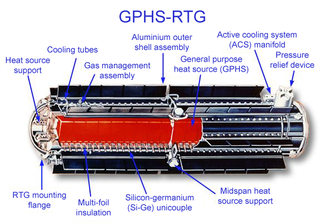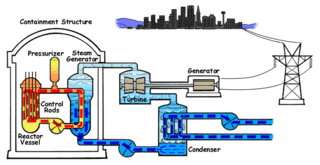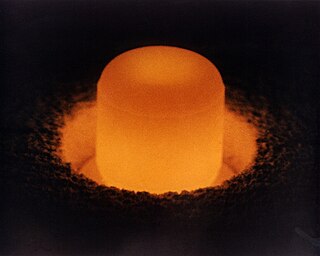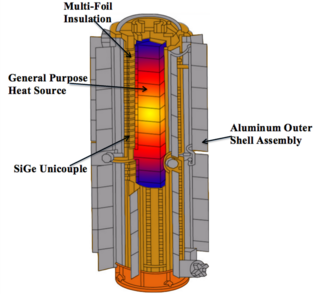This list of nuclear power systems in space includes 81 nuclear power systems that were flown to space, or at least launched in an attempt to reach space. Such used nuclear power systems include:
- radioisotope heater units (RHU) (usually produce heat by spontaneous decay of 238
Pu
) - radioisotope thermoelectric generators (RTG) (usually produce heat by spontaneous decay of 238
Pu
and convert it to electricity using a thermoelectric generator) - miniaturized fission reactors (usually produce heat by controlled fission of highly enriched 235
U
and convert it to electricity using a thermionic converter)
Systems never launched are not included here, see Nuclear power in space.
Initial total power is provided as either electrical power (We) or thermal power (Wt), depending on the intended application.
| Nation | Mission | Launched | Fate / location | Technology | Nuclear fuel | Power (nominal) | Ref |
|---|---|---|---|---|---|---|---|
| Transit-4A | 1961 | Earth orbit | RTG SNAP-3B | 238 Pu | 2.7 We | [1] | |
| Transit-4B | 1961 | Earth orbit | RTG SNAP-3B | 238 Pu | 2.7 We | [1] | |
| Transit 5BN-1 | 1963 | Earth orbit | RTG SNAP-9A | 238 Pu | 25.2 We | [1] | |
| Transit 5BN-2 | 1963 | Earth orbit | RTG SNAP-9A | 238 Pu | 26.8 We | [1] | |
| Transit 5BN-3 | 1964 | Failed to reach orbit, burned up in atmosphere. | RTG SNAP-9A | 238 Pu | 25 We | [2] | |
| SNAPSHOT | 1965 | Low graveyard orbit in 1300 km height | fission reactor SNAP-10A | 235 U (uranium-zirconium hydride) | 500 We | [1] | |
| Nimbus B (Nimbus-B1) | 1968-05-18 | Crashed at launch, radioactive material from RTG recovered from ocean and reused | RTG SNAP-19B (2) | 238 Pu | 56 We | [1] [3] | |
| Nimbus 3 (Nimbus-B2) | 1969-04-14 | Earth re-entry 1972 | RTG SNAP-19B (2) | 238 Pu | 56 We | [1] | |
| Nimbus IV | 1970 | Earth orbit | RTG SNAP-19 | [4] | |||
| Nimbus V | 1972 | Earth orbit | RTG SNAP-19 | [4] | |||
| Nimbus VI | 1975 | Earth orbit, damaged | RTG SNAP-19 | [4] | |||
| Nimbus VII | 1978 | Earth orbit, damaged | RTG SNAP-19 | [4] | |||
| Apollo 11 | 1969 | RHU (2) | 30 Wt | [1] | |||
| Apollo 12 ALSEP | 1969 | Lunar surface (Ocean of Storms) [5] | SNAP-27 | 238 Pu | 73.6 We | [1] | |
| Apollo 13 ALSEP | 1970 | Earth re-entry (Pacific Ocean, Tonga Trench) | RTG SNAP-27 | 238 Pu | 73 We | [1] | |
| Apollo 14 ALSEP | 1971 | Lunar surface (Fra Mauro) | RTG SNAP-27 | 238 Pu | 72.5 We | [1] | |
| Apollo 15 ALSEP | 1971 | Lunar surface (Hadley–Apennine) | RTG SNAP-27 | 238 Pu | 74.7 We | [1] | |
| Pioneer 10 | 1972 | Ejected from Solar System | RTG SNAP-19 (4) + RHU (12) | 238 Pu | 162.8 We + 12 Wt | [1] | |
| Apollo 16 ALSEP | 1972 | Lunar surface (Descartes Highlands) | RTG SNAP-27 | 238 Pu | 70.9 We | [1] | |
| TRAID-01-1X | 1972 | Earth orbit | RTG SNAP-19 | 238 Pu | 35.6 We | [1] | |
| Apollo 17 ALSEP | 1972 | Lunar surface (Taurus–Littrow) | RTG SNAP-27 | 238 Pu | 75.4 We | [1] | |
| Pioneer 11 | 1973 | Ejected from Solar System | RTG SNAP-19 (4) + RHU (12) | 238 Pu | 159.6 We + 12 Wt | [1] | |
| Viking 1 | 1976 | Mars surface (Chryse Planitia) | lander modified RTG SNAP-19 (2) | 238 Pu | 84.6 We | [1] | |
| Viking 2 | 1976 | Mars surface (Utopia Planitia) | lander modified RTG SNAP-19 (2) | 238 Pu | 86.2 We | [1] | |
| LES-8 | 1976 | Near geostationary orbit | MHW-RTG (2) | 238 Pu | 307.4 We | [1] | |
| LES-9 | 1976 | Near geostationary orbit | MHW-RTG (2) | 238 Pu | 308.4 We | [1] | |
| Voyager 1 | 1977 | Ejected from Solar System | MHW-RTG (3) + RHU(9) | 238 Pu | 477.6 We + 9 Wt | [1] | |
| Voyager 2 | 1977 | Ejected from Solar System | MHW-RTG (3) + RHU(9) | 238 Pu | 470.1 We + 9 Wt | [1] | |
| Mars 2020/Perseverance | 2020 | Mars surface | MMRTG | 238 Pu | 110 We | [6] | |
| Galileo | 1989 | Jupiter atmospheric entry | GPHS-RTG (2) | 576.8 We | [1] | ||
| Ulysses | 1990 | Heliocentric orbit | GPHS-RTG | 283 We | [1] | ||
| Cassini | 1997 | Burned-up in Saturn's Atmosphere | GPHS-RTG (3) | 238 Pu | 887 We | ||
| New Horizons | 2006 | Pluto and beyond | GPHS-RTG (1) | 238 Pu | 249.6 We | ||
| MSL/Curiosity rover | 2011 | Mars surface | MMRTG | 238 Pu | 113 We | ||
| Kosmos 84 | 1965 | Earth orbit | Orion-1 RTG | 210 Po | [4] [7] | ||
| Kosmos 90 | 1965 | Earth orbit | Orion-1 RTG | 210 Po | [4] [7] | ||
| Kosmos 198 (RORSAT) | 1967-12-27 | Earth orbit | Fission reactor BES-5 ?? | 235 U | [4] [8] | ||
| Kosmos 209 (RORSAT) | 1968-03-22 | Earth orbit | Fission reactor BES-5 ?? | 235 U | [4] [8] | ||
| Kosmos 305 (Moon) | 1969-10-22 | Failed to leave Earth orbit towards the Moon, burned up in atmosphere 2 days after launch | ?? | ?? | ?? | [4] [9] [10] [11] | |
| Kosmos 367 (RORSAT) | 1970-10-03 | Earth orbit, 579 mile altitude | Fission reactor BES-5 ?? | 235 U | 2 kWe | [4] [8] [12] | |
| Kosmos 402 (RORSAT) | 1971 | Earth orbit | Fission reactor BES-5 ?? | 235 U | 2 kWe | [4] [8] | |
| Kosmos 469 (RORSAT) | 1971 | High orbit | Fission reactor BES-5 (officially confirmed) | 235 U | 2 kWe | [13] | |
| Kosmos 516 | 1972 | High orbited 1972 | Fission reactor BES-5 | 235 U | 2 kWe | [13] | |
| RORSAT | 1973 | Launch failure over Pacific Ocean, near Japan | Fission reactor BES-5 | 235 U | 2 kWe | [13] | |
| Kosmos 626 | 1973 | Earth orbit | Fission reactor BES-5 | 235 U | 2 kWe | [13] | |
| Kosmos 651 | 1974 | BES-5 | 235 U | 2 kWe | [13] | ||
| Kosmos 654 | 1974 | BES-5 | 235 U | 2 kWe | [13] | ||
| Kosmos 723 | 1975 | BES-5 | 235 U | 2 kWe | [13] | ||
| Kosmos 724 | 1975 | BES-5 | 235 U | 2 kWe | [13] | ||
| Kosmos 785 | 1975 | failed after reaching orbit | BES-5 | 235 U | 2 kWe | [13] | |
| Kosmos 860 | 1976 | BES-5 | 235 U | 2 kWe | [13] | ||
| Kosmos 861 | 1976 | BES-5 | 235 U | 2 kWe | [13] | ||
| Kosmos 952 | 1977 | BES-5 | 235 U | 2 kWe | [13] | ||
| Kosmos 954 | 1977 | Exploded on re-entry 1978 (over Canada) | BES-5 | 235 U | 2 kWe | [13] | |
| Kosmos 1176 | 1980 | 11788/11971 Earth orbit 870–970 km | BES-5 | 235 U | 2 kWe | [13] | |
| Kosmos 1249 | 1981 | BES-5 | 235 U | 2 kWe | [13] | ||
| Kosmos 1266 | 1981 | BES-5 | 235 U | 2 kWe | [13] | ||
| Kosmos 1299 | 1981 | BES-5 | 235 U | 2 kWe | [13] | ||
| Kosmos 1402 | 1982 | Earth re-entry 1983 (South Atlantic) | BES-5 | 235 U | 2 kWe | [13] | |
| Kosmos 1372 | 1982 | BES-5 | 235 U | 2 kWe | [13] | ||
| Kosmos 1365 | 1982 | BES-5 | 235 U | 2 kWe | [13] | ||
| Kosmos 1412 | 1982 | BES-5 | 235 U | 2 kWe | [13] | ||
| Kosmos 1461 | 1983 | Earth orbit, exploded | BES-5 | 235 U | 2 kWe | [4] | |
| Kosmos 1597 | 1984 | BES-5 | 235 U | 2 kWe | [13] | ||
| Kosmos 1607 | 1984 | High orbited 1985 | BES-5 | 235 U | 2 kWe | [13] | |
| Kosmos 1670 | 1985 | High orbited 1985 | BES-5 | 235 U | 2 kWe | [13] | |
| Kosmos 1677 | 1985 | High orbited 1985 | BES-5 | 235 U | 2 kWe | [13] | |
| Kosmos 1736 | 1986 | High orbited 1986 | BES-5 | 235 U | 2 kWe | [13] | |
| Kosmos 1771 | 1986 | High orbited 1986 | BES-5 | 235 U | 2 kWe | [13] | |
| Kosmos 1900 | 1987 | Earth orbit, 454 mile altitude | BES-5 | 235 U | 2 kWe | [13] [12] | |
| Kosmos 1860 | 1987 | Fission reactor BES-5 | 235 U | 2 kWe | [13] | ||
| Kosmos 1932 | 1988 | Earth orbit 800–900 km | fission reactor BES-5 | 235 U | 2 kWe | [13] | |
| Kosmos 1682 | 1985 | High orbited 1986 | fission reactor BES-5 | 235 U | 2 kWe | [13] | |
| Kosmos 1818 (RORSAT) | 1987 | Destroyed in high Earth orbit | fission reactor Topaz-I | 235 U | 5 kWe | [14] | |
| Kosmos 1867 (RORSAT) | 1987 | Parked in high Earth orbit | fission reactor Topaz-I | 235 U | 5 kWe | [15] | |
| Lunokhod 201 | 1969-02-19 | Rocket exploded at launch, radioactive material from RHU spread over Russia | RHU | 210 Po | [16] | ||
| Lunokhod 1 | 1970 | Lunar surface | RHU | 210 Po | [16] | ||
| Lunokhod 2 | 1973 | Lunar surface | RHU | 210 Po | [16] | ||
| Mars 96 | 1996 | Launch failure, entered Pacific Ocean | RHU (4) | 238 Pu | [16] | ||
| Chang'e 3 and Yutu | 2013 | Lunar surface | several RHU's, RTG (??) (some electricity provided by solar panels) | 238 Pu | [17] | ||
| Chandrayaan-3 | 2023 | Lunar orbit | RHU | 241Am | 2 Wt | [19] |













